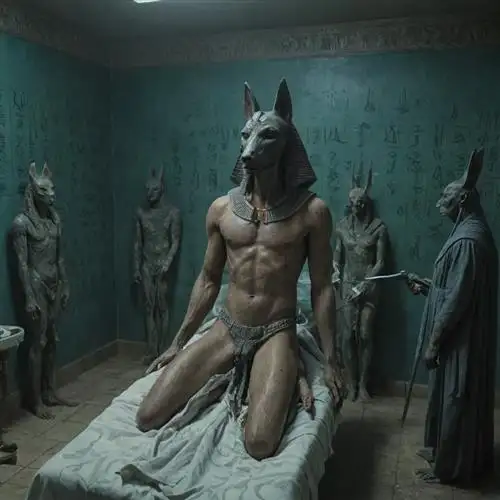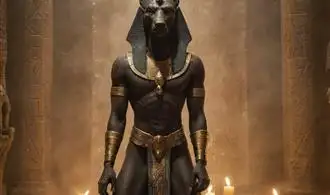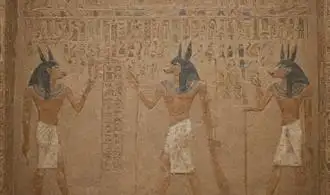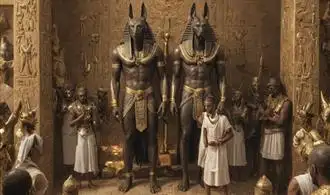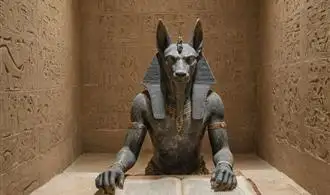
The Enigmatic Jackal-Headed God
Anubis, the enigmatic jackal-headed god, has long been a figure of fascination in the pantheon of ancient Egyptian deities. While the more well-known gods like Ra and Osiris often take center stage, Anubis' unique role and enduring symbolism make him a divinity worthy of deeper exploration. As the god of the dead, embalming, and the underworld, Anubis held a pivotal position in the complex religious beliefs of the ancient Egyptians.
What sets Anubis apart is his distinct iconography - the jackal or dog-like head perched atop a human body. This distinctive feature has led to much speculation and analysis, with scholars offering various interpretations of its significance. Some believe the jackal-headed form was chosen to represent Anubis' role as the guardian of cemeteries and protector of the dead, as jackals were commonly found prowling near burial sites.
Anubis' primary responsibility was to oversee the mummification process and ensure the safe passage of the deceased into the afterlife. He was present at the weighing of the heart ceremony, where the heart of the dead was balanced against the feather of truth. This ritual was crucial, as it determined whether the individual would be granted access to the paradise of the afterlife or condemned to eternal damnation.
Beyond his funerary duties, Anubis was also associated with the regeneration of life and the cycle of death and rebirth. His connection to the underworld and the transition between the mortal and divine realms made him a pivotal figure in the ancient Egyptian belief system. I Tried Worshipping Anubis for a Month and This is What Happened delves deeper into the personal experiences of individuals who have sought to connect with this enigmatic deity.
Interestingly, Anubis was not always the sole deity associated with the underworld and the dead. In earlier periods of Egyptian history, other gods, such as Anubis' counterpart, Wepwawet, also played significant roles in the funerary rites and the afterlife journey. The interplay and evolution of these deities over time highlight the rich and complex nature of ancient Egyptian mythology.
Guardians of the Dead and Embalmers Extraordinaire
Anubis, the Egyptian god of the dead, was a figure of immense importance in ancient Egyptian culture. Often overshadowed by the more famous gods like Ra and Osiris, Anubis played a crucial role as the guardian of the dead and the embalmer extraordinaire. His responsibilities were vital in the intricate rituals and beliefs surrounding the afterlife.
As the guardian of the dead, Anubis was tasked with the crucial duty of guiding the souls of the deceased through the perilous journey to the afterlife. He was present at the moment of death, standing vigil over the body and ensuring a safe passage for the spirit. Anubis was believed to weigh the heart of the deceased against the feather of truth, determining whether the individual was worthy of entering the afterlife. This process, known as the "weighing of the heart," was a central component of the Egyptian concept of the afterlife.
But Anubis's role extended far beyond just guiding the dead. He was also revered as the master of embalming, a practice that was essential to the preservation of the physical body for the afterlife. Anubis's expertise in the art of mummification was unparalleled, and he was said to have taught the techniques to the ancient Egyptians. The meticulous process of embalming, which involved the removal of internal organs, the desiccation of the body, and the wrapping in linen bandages, was a critical step in ensuring the deceased's successful transition to the afterlife.
Anubis's role as the embalmer extraordinaire was not just a practical one; it was also deeply symbolic. The preservation of the physical body was seen as essential for the soul's continued existence in the afterlife. Anubis's mastery of this process made him a pivotal figure in the Egyptian belief system, and his presence was always felt in the rituals and ceremonies surrounding the dead.
In addition to his duties as the guardian of the dead and the embalmer, Anubis was also responsible for the protection of the deceased during their journey to the afterlife. He was believed to watch over the mummification process, ensuring that the body was prepared correctly and that the spirit was able to depart safely. This protective aspect of Anubis's character made him a revered and respected figure among the ancient Egyptians.
The Weighing of the Heart Ceremony
The Weighing of the Heart Ceremony was a crucial and awe-inspiring ritual in ancient Egyptian mythology, centered around the figure of Anubis, the god of the dead. This ceremony played a vital role in the afterlife journey of the deceased, determining their worthiness to enter the realm of the eternal and harmonious existence.
Anubis, often depicted with the head of a jackal, was the primary figure presiding over this ritual. As the god associated with embalming, mummification, and the protection of the dead, Anubis held a sacred responsibility in ensuring the deceased individual's journey to the afterlife was successful. The Weighing of the Heart Ceremony was the pivotal moment where the deceased's actions and deeds were judged, with their heart being weighed against the feather of Maat, the goddess of truth, justice, and cosmic order.
The process of the Weighing of the Heart Ceremony was a meticulous and solemn affair. The deceased individual's heart, believed to be the seat of their soul and moral character, was placed on one side of a scale. On the other side, the feather of Maat represented the standard of truth and righteousness. If the heart balanced evenly with the feather, it was considered pure and the individual was deemed worthy to pass into the afterlife. However, if the heart was heavier, indicating a life filled with misdeeds and a lack of moral rectitude, it would be devoured by the fearsome demon Ammit, effectively condemning the soul to eternal oblivion.
The presence of Anubis as the overseer of this ritual was crucial. As the god who guided the dead through the perilous journey to the afterlife, Anubis would carefully observe the proceedings, ensuring the scales were balanced fairly and that the deceased individual's fate was determined with absolute justice. The heart's successful passage through this ceremony was seen as a testament to the individual's adherence to the principles of Maat, securing their eternal reward in the afterlife.
The Forgotten Cult of Anubis
Anubis, the enigmatic jackal-headed deity, was a central figure in the pantheon of ancient Egyptian gods. Yet, despite his profound significance, his cult has largely faded from modern consciousness. Delving into the forgotten realm of the Anubis cult reveals a rich tapestry of beliefs, rituals, and the enduring influence of this enigmatic god.
At the heart of the Anubis cult lay the belief that this deity presided over the process of mummification and the afterlife. As the god of the dead, Anubis was responsible for guiding the deceased through the treacherous journey to the afterlife, ensuring a safe passage and a successful transition. This role earned Anubis a revered status among the ancient Egyptians, who placed immense importance on the proper preparation and preservation of the dead.
The Anubis cult was centered in the Cynopolis region, where the god was worshipped as the primary deity. Here, the faithful engaged in intricate rituals and ceremonies designed to honor Anubis and secure his divine favor. These practices included the mummification of sacred animals, such as jackals and dogs, which were believed to be manifestations of the god. The mummified remains were then interred in elaborate tombs, serving as sacred offerings and representations of Anubis himself.
Beyond the Cynopolis region, the cult of Anubis held sway across ancient Egypt. Temples and shrines dedicated to the god were established in various cities, each with its own unique traditions and practices. In these sanctuaries, worshippers would engage in rituals, make offerings, and seek the guidance and protection of Anubis in their journey to the afterlife.
One of the most intriguing aspects of the Anubis cult was its association with the embalming process. The jackal-headed deity was believed to oversee the mummification of the deceased, ensuring the proper preservation of the body and the soul's safe passage to the afterlife. Anubis was often depicted standing over the embalming table, guiding the priests and embalmers in their sacred work.
The significance of Anubis extended beyond the realm of the dead, as the god was also revered for his role in the judgment of the soul. In the famous "weighing of the heart" ceremony, Anubis would preside over the process, ensuring the deceased had lived a virtuous life. This belief in Anubis as the arbiter of justice and the guardian of the afterlife cemented his status as a crucial figure in the ancient Egyptian religious and cultural framework.
Reviving the Worship of Anubis
Reviving the Worship of Anubis requires a deep understanding of this enigmatic Egyptian god and his significance in the ancient world. Anubis, the jackal-headed deity, was revered as the guardian of the dead, the embalmer, and the protector of the mummification process. His role was crucial in the journey of the deceased through the afterlife, making him a central figure in the Egyptian funerary cult.
To revive the worship of Anubis, it is essential to reconnect with the core principles and rituals associated with this deity. One of the most important aspects is the recognition of Anubis as the patron of the underworld, the guide who ensures the safe passage of the deceased through the perilous realms of the afterlife. By honoring Anubis, devotees can seek his guidance and protection, ensuring a smooth transition to the next life.
Rituals and practices associated with Anubis can be varied and intricate. From the meticulous mummification process to the recitation of spells and incantations, the worship of Anubis was deeply rooted in the Egyptian spiritual tradition. 5 Surprising Anubis Rituals You Need to Try delves into the fascinating and often overlooked practices that can be revived to connect with this powerful deity.
Moreover, the iconography of Anubis, with his distinctive jackal-like head, holds immense symbolic significance. Incorporating Anubis imagery, whether through statues, amulets, or other sacred objects, can be a powerful way to invoke his presence and tap into the ancient energies associated with this revered god.


